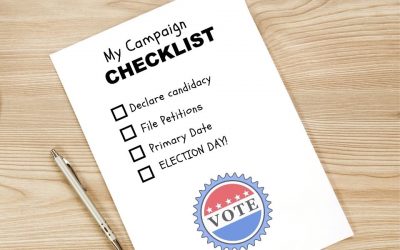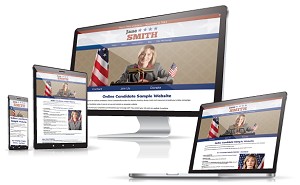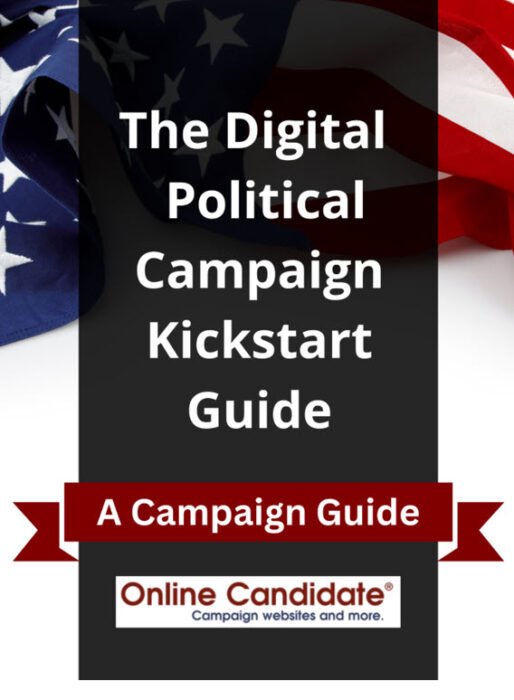Choosing the Best Political Campaign Handle
Here’s a tip for creating social media handles for your political campaign: Pick a single name that’s going to last for both your campaign website and social media profiles.
One frequent question we get when someone is starting a campaign whether you should include the name of the office you are seeking in your website and social profiles.
In our opinion, you should avoid using an office name in your website domain name and social media handles. It’s better to use just your name and/or include a more generic “vote for” or “elect” in the handle.
Here’s why. If you’re going to be in politics for a long time, chances are the position you’re looking for will change in the future. If that happens, some of the work done to build your online presence will go to waste.
 For example, on a candidate Facebook page, after you have secured a certain number of “likes,” you can change your page address to a unique username. However, once you choose a name, you cannot change it in the future. So if your Facebook page is facebook.com/smithforsupervisor, your followers could be lost if you run for a different office and start a new page under a different page name. It can be tough to get your old followers to like and follow a new page.
For example, on a candidate Facebook page, after you have secured a certain number of “likes,” you can change your page address to a unique username. However, once you choose a name, you cannot change it in the future. So if your Facebook page is facebook.com/smithforsupervisor, your followers could be lost if you run for a different office and start a new page under a different page name. It can be tough to get your old followers to like and follow a new page.
The same goes for a campaign’s Twitter account. Choose your username carefully. At some point, it will look silly if your social media handle is @smithformayor when you are running for state representative. It may be tough to set up a new account and rebuild your following.
Even if you manage to change your page names or accounts, there may be many links from other sites pointing to the old locations. Broken links don’t help anyone.
Tips for choosing a good campaign social media handle:
- Keep it simple, short, and easy to remember
- Use your real name or ballot name
- Avoid using numbers or special characters
- Make the name consistent across all platforms, if possible
Before you commit to a handle and create any accounts, check and make sure they are available on all the platforms you plan to use. This can save you the hassle of using different or variant names on different services.
For your campaign site, we recommend that you register your name or include a variant with “Vote” or “Elect” as the domain name. That way, if you later want to run for a different office, switching the political website will be easier. All the old links and traffic will remain, making it easier to restart your online campaign.
When starting a run for political office, choose your online names carefully. And be prepared to keep them for a while!
Online Candidate websites include an easy-to-use interface, tools, and design options to make building your online presence as pain-free as possible. Get started in minutes! Check out our website packages.
10 Facts About Digital Political Campaigning To Keep You Up at Night
What scares you most about running for office? For many individuals, the thought of running for office can be both exciting and daunting.
From asking people to donate to your campaign to the pressure of public speaking, there are numerous fears associated with campaigning that can feel overwhelming. Online campaigning adds its own unique challenges that require planning and attention to detail.
And if that isn’t enough, here are ten more things you might not know that can absolutely ruin your online campaign.
Your digital past can damage your campaign
If you’ve ever had embarrassing photos, tweets, posts, or other online information put online, there’s a good chance that they still exist in some form. Even if you try to do an online cleanup, it’s hard to fully eliminate everything out there. Saved screen shots, old photos on a hard drive somewhere, and even old social media posts can return to bite you.
Tip: Regularly review your digital history and remove or address problematic content. Don’t wait for opponents to find it first. Because they will.
Even offline, your reputation is online
Just because you’ve sworn off online campaigning doesn’t mean that newspaper articles and other material doesn’t exist about you online. When you become a political candidate, you become a public figure. If you are not putting information about yourself online, then someone else will.
Although it may feel overwhelming at times, monitoring your online mentions and setting up alerts can help you stay informed and prepared for any situation.
Free Digital Campaigning Tips: Subscribe for free guides and updates.
Your domain name can be hijacked before you start
Even if you are in the planning stages of running for office, you should reserve your domain name. If someone else registers the domain name, you may have a tough time getting it back. Often nothing is done with a high-jacked name, but announcing a website before you have registered the domain (or actually created the website) is just asking for trouble.
Your campaign branding can be hijacked, too
Political websites or accounts clearly designed to trick people into thinking they’re on a legitimate campaign website have been on the rise over the last decade. These spoof sites suggest the look and feel of legitimate sites. At first glance, they appear to be supporting a candidate, but in reality, they might providing misinformation or even raising funds for the opposition. Donors beware!
 There’s no guarantee that the web will pull in money
There’s no guarantee that the web will pull in money
The web is a powerful tool for fundraising, but it’s not a shortcut. Just because you slapped a donation button on your website and your social profiles does not guarantee that you will raise a single dollar. You need the right tools, messaging, and real support to raise funds. Done properly, the effort put into online fundraising can pay off handsomely. If you do it poorly, well…
Related: How Local Political Candidates Raise Money
Social media accounts get hacked … regularly
Social media account takeovers had increased over 1000% percent from 2020 to 2021, and have continued to rise in the 2020s. With those kinds of numbers, you’ll want to keep an eye on your campaign’s social media profiles. If multiple people have access to your campaign accounts, the risk of unauthorized access is increased. Best practices include limiting the number of people with social media account access. Only give people the minimum amount of access they need, and change account passwords frequently.
Tip: Use a password manager to securely store and rotate your campaign account credentials.
Social media accounts get mixed up … regularly
How many times have we heard about politicians posting inappropriate material to their social media accounts? You may wonder why this happens so often. The reason is simple. In most cases, someone posted publicly what was to be a private message sent to an individual. In other cases, someone (usually a staffer) was logged into the campaign’s social media account instead of their own. Either way, this can lead to an embarrassing situation requiring deletions, apologies, and negative media coverage.
Tip: Maintain separate devices or browsers for your campaign and personal accounts.
What you post is yours … until it isn’t
Your Facebook page, Instagram, and X / Twitter accounts are subject to the generosity of those services. Follow the rules for posting. Remember that these services can pretty much remove anything they want, at any time. If someone claims you are violating their terms of service, you could be in trouble. Losing a social media account late in the election cycle can be disastrous!
Just a few bad emails can cripple your email system
If a few people on your campaign email list don’t like your messages and report you as a spammer, it could ruin your chances for future messages to get through to anyone. Email service providers are quick to suspend accounts that are suspected of spamming.
Tip: Clean up your email lists regularly. Best practices include using double opt-in for new subscribers, and monitoring engagement metrics like open and click-through rates, and limiting the number of links in your messages.
Even when it’s over, it’s not over
If your election is over, consider hanging onto your website. If you let your domain name lapse, someone else can pick it up. You’ll probably have a tough time getting it back. Also, you’ll also have no control over a new website that someone may create with your lapsed domain name.
Online Candidate has been a trusted leader in candidate websites for over 20 years. We provide monthly and annual website packages with design and setup included. Explore our services today to see how we can help your campaign succeed.
Planning Your Political Campaign – Candidate Checklists
A solid plan is key to any political victory. While it might be tempting to announce your candidacy as soon as you can, it is often not a wise move. There are many tasks required in preparing for a campaign. Candidate checklists play a big part in organizing your efforts. Being prepared will allow your team to hit the ground running.
In this article, we are going to put together a series of political candidate checklists for tasks when running for office.
Article Highlights:
- Candidate Preparation: Prioritize planning, gather contacts, and research your public history.
- Campaign Timeline & Strategy: Set clear campaign calendars, know your deadlines, and define key issues.
- Outreach & Messaging: Use a variety of outreach techniques, maintain consistent branding, and tailor your message.
- Post-Campaign Activities: Thank supporters, analyze election results, and close campaign operations efficiently.
Get a list of your contacts
 One of the first steps in putting together a campaign plan is to gather a list of people who you think will support your candidacy. Are there people you know who can play a role in your campaign team? You probably know more people who can act as volunteers or even your initial donors. Now is the time to pull out your phone contact list (or, for you older readers, your Rolodex).
One of the first steps in putting together a campaign plan is to gather a list of people who you think will support your candidacy. Are there people you know who can play a role in your campaign team? You probably know more people who can act as volunteers or even your initial donors. Now is the time to pull out your phone contact list (or, for you older readers, your Rolodex).
Your contacts can include:
- Friends
- Family
- Present and past co-workers
- Business and professional contacts
- Contacts from organizations and memberships
- Party officials / Elected officials
- Schoolmates
Once you have gathered your contacts and their information, you will need to keep them organized. To do so, put them on a spreadsheet, database, or a CRM. When you are ready to reach out to these people, you will be able to find them easily and track the support they provide.
“The checklist is one of the most high powered productivity tools ever discovered.” – Brian Tracy
Research your public history
Do you know your own public history? If not, then you will need to conduct some in-depth research on yourself. Knowing what information about you is available can help you avoid any pitfalls that may come your way.
Your personal information may include:
- Current and prior addresses
- Mortgages and loans
- Property ownership / taxes and liens
- Employment history
- Licenses and certifications
- Military service
- Court proceedings and judgements
- Criminal record
- Statements of public record
- Social media accounts
- Public campaign finance records (donors and donations)
The more you know about your own public information, the less chance another candidate has of surprising you with a bombshell accusation. In addition, you will be prepared for whatever mud is slung your way.
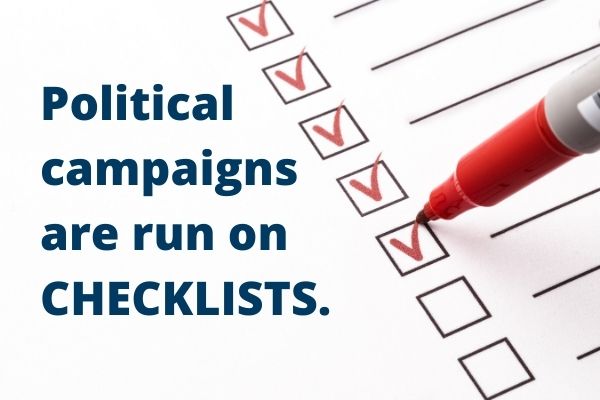
Do your homework on the position you seek
You may be running for town council, mayor, school board, coroner, or dog catcher. No matter what elected position you are running for, it is wise to learn everything you can about the position you seek. If possible, put together a team that can help you learn the most about your potential new job. Knowing what is required will allow you to quickly act once you have been voted in. Also, if you appear to be knowledgeable about the position, people are more likely to vote for you.
What you should know about the position:
- Legal duties and powers assigned to the elected position
- Position within the government structure
- Schedule of workday and meetings
- Ceremonial duties
- Salary and benefits
- What was required for the current office holder to be elected
Create candidate checklists for your campaign timeline
This can be broken out into its own checklist – or multiple checklists. You need to know the timeline for your campaign. Some things will be in your control, such as when you hold fundraisers or public events. Other dates will be determined by your local election law.
A typical campaign calendar checklist includes:
- Nomination filing date
- Petition filing deadlines
- Financial reporting schedule
- Primary date
- Election date
- Final financial report
Compliance with deadlines is a must. Candidates can and do get kicked off a ballot for not adhering to proper deadlines.
Other campaign timelines include:
- Your fundraising schedules
- Volunteer efforts
- Candidate appearances
- Debates
- Advertising schedule
- Staff meetings
- Bulk mailings
- Sign distribution
Count on creating plenty of campaign calendars throughout the season. You’ll need campaign staff that is organized and prepared to work with a plan. They will also have to deal with unexpected events as they come up.
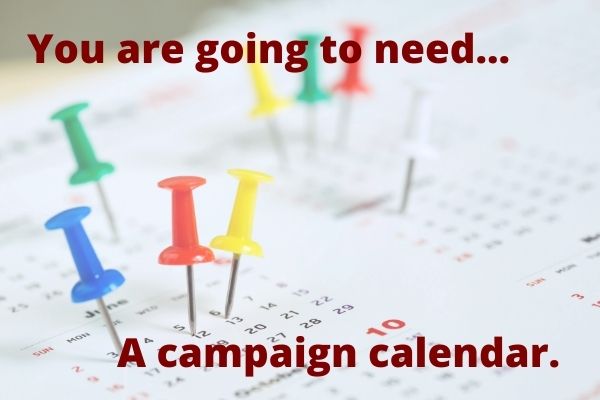
Develop your positions on the issues
While developing your campaign strategy, you will need to adopt positions on the issues. This is incredibly important and should never be overlooked. Your political positions will be the heart of your campaign and will show voters where you stand.
Candidate issue checklist:
- What are the major issues?
- Rank issues in matters of importance.
- What is my position on each issue?
- What is the most important issue that the candidate will take as their own?
- Prepare written statements of the candidate’s positions.
- What is my opponent’s position on each issue?
Put together material for print and web
- Gather Photos: You will need to gather pictures for use in your campaign. You need a good headshot, of course. Also, get pictures of you with your family and of you being active in your community. Consider hiring a professional photographer to put together a strong portfolio.
- Utilize Past Materials: If you have run for office in the past, you may be able to recycle some of the content of your old campaign material into your current race.
Write a personal biography
When you run for office, voters need to learn about you and who you are. In many local elections, voters will simply skip the line for candidates they know little or nothing about. Developing a personal biography as part of your candidate checklist is so important. You will want to include not only your professional history but also your personal history.
The basics of candidate bio include:
- An introduction
- Your experience
- Personal details
- What you hope to accomplish in office
If you are not great at writing, you may want to have a copywriter do the job for you. Choose a writer that specializes in biographical writing to get the best results.
“If you don’t tell your own story and define yourself, your opponent will.”
Build your own brand
As an election ultimately ‘sells’ a political candidate, you will need develop a brand to represent you.
This includes your:
- Colors
- Campaign slogan
- Campaign logo
- Stock images of yourself
Everything should come together to best represent your own personal style. When it is done right, voters will see your campaign material and will immediately associate them with you.
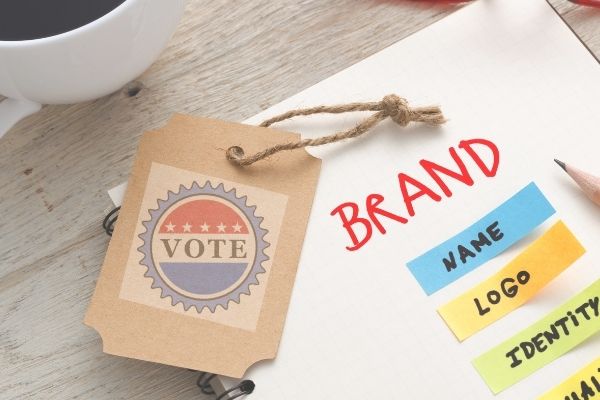
Develop an online presence to reach voters
Conducting a self-search is the first step in developing an online presence. Put your name in the search engine and see what comes up on the first few pages. This will give you a good idea of what people see when they Google your name. If what you find is negative, you will need to improve your online image. Below are a few things that can help you influence your online presence and build a solid online brand.
- Create a website: As a candidate, you will need a place online to share your message, provide updates, and accept online donations.
- Develop a social media plan: In today’s world, no political campaign plan would be complete without social media.
- Prepare for digital advertising: With a low barrier to entry, even local candidates can put together an effective online political marketing strategy.
Recommended reading: How Much Should Your Political Campaign Budget For Digital?
“A checklist cannot fly a plane. Instead, they provide reminders of only the most critical and important steps.” – Atul Gawande
Put together a fundraising plan
Raising money is essential for exposure. From small-dollar donations to large corporate contributions, every dollar is important. You’ll need a solid plan to start fundraising and keeping the money flowing through election day.
Online Donations:
- Optimize your campaign website for mobile donations.
- Set up secure online payment systems to ensure donor trust.
- Promote recurring donations for consistent funding.
- Encourage small-dollar donations from a broad base.
- Use social media challenges to boost efforts.
Fundraising Events:
- Organize events like dinners and rallies with influential speakers.
- Offer tiered donation levels with benefits, such as extra swag or photos with the candidate.
- Sell campaign merchandise like shirts, hats, and pins.
- Consider hosting virtual fundraising events for broader reach.
Corporate and PAC Donations:
- Understand legal limits of contributions.
- Make sure your reporting remains up to date.
- Build relationships with aligned industry groups. This can include businesses, unions, or other affiliated organizations.
- Host industry-specific roundtables or discussions about the issues.
- Provide regular updates to large and corporate donors about campaign progress.
Voter outreach
Direct voter outreach is the core of any political campaign. It’s about making genuine connections, understanding voter concerns, and presenting your vision to address the issues. Here is a list of outreach techniques you’ll use:
Targeted Voter Canvassing:
- Before you hit the streets, you need to know know where to go. Use data analytics to identify neighborhoods and demographics likely to support you.
- Equip volunteers with campaign literature, talking points, and a feedback system.
- Use mobile apps to track and manage canvassing efforts in real-time. It will help track your volunteers and gather data efficiently.
- Regularly train and update your volunteers on campaign developments and strategies.
Phone Banking and Texting:
- Train volunteers on effective phone scripts and objection handling.
- Use auto-dialer systems for efficiency.
- Follow-up with text messages after calls to provide additional information or resources for interested voters.
- Track responses and call feedback to refine your overall outreach strategy.
- Encourage supporters to talk to their friends, family, and neighbors about your campaign.
Digital Outreach:
- Utilize targeted ads on platforms like Facebook, Google, and X/Twitter. (And make sure you are authorized to advertise well in advance.)
- Engage with voters through webinars, virtual town halls, and Q&A sessions.
- Use text messaging (SMS) campaigns to send updates, reminders, and calls to action.
- Use email Campaigns to regularly update your supporters with newsletters, updates, and calls to action.
- Social Media Engagement: Regularly post content, respond to comments, and engage in online discussions to maintain an active online presence.
- Video Content: Create and share campaign videos or live streams to reach a broader audience.
We have seen too many clients wait to authorize their campaigns for online advertising platforms. If you wait too long, you’ll miss the opportunity to run digital ads. Start the process as early as you can!
Direct Mail Campaigns:
- Design compelling mailers with clear calls to action.
- Segment your mailing list for personalized messages.
- Include QR codes on mailers for easy access to digital resources or donation pages.
- Feedback Mechanism: Add a way for recipients to provide feedback or ask questions, such as a website form or social media account that is monitored.
Messaging and Communication
Ensure your message is clear and consistent. You’ve probably noticed that the most successful politicians hammer away at the same message over and over. Every stump speech, every interview, and every ad will use the same talking points.
Consistent Branding:
- Develop a consistent visual identity as discussed above.
- Ensure all campaign materials reflect this branding.
- Use your style guide for all campaign communications.
Tailored Messaging:
- Segment your audience for resonant messages.
- Test different messages for effectiveness.
- Use data analytics to refine your messaging strategies.
- Don’t just broadcast. Understand voter concerns by speaking with and interacting with voters and organizations.
Rapid Response:
- Monitor news and social media for negative publicity.
- Use platforms like X/Twitter for real-time communication.
- Set up a dedicated PR team for damage control.
- Engage directly with supporters to counteract negative publicity.
Post-Campaign Activities
Whether you win or lose, you should take the time to properly wrap up your campaign. Here are some items you’ll want to do after election day.
Thank Yous:
- Send personalized thank you notes to supporters.
- Organize appreciation events for your team.
- Update your website to announce the results of the race.
Election Analysis:
- Conduct a post-mortem analysis to find out what worked and what did not.
- Gather feedback from staff, volunteers, and your primary team for future campaigns.
- Analyze the overall voter turnout and demographics to better understand your victory or loss.
- Review your numbers to figure out where you spent your budget, and how it could have been spent better.
Shut it Down:
- Contact vendors and get any remaining payments settled ASAP.
- Close accounts that are not needed, so that you do not get billed.
- Archive campaign materials for future reference.
- Hold a final team meeting to acknowledge everyone’s efforts. Discuss the next steps.
In conclusion
Now that you have some helpful checklist ideas, why not start putting your political plan into action?
The sooner you start, the better you will be prepared when it comes time to hit the campaign trail. With a solid plan in place, your chances of victory are much higher.
Download a PDF version of these checklists: Political-Campaign-Checklist-For-Candidate
For more checklists tips, tricks and useful strategies, see our book Running For Office as an Online Candidate. It provides a digital blueprint and strategy to help you win.
Running in the Next Election? Better Start Preparing Now
We are barely past the November general elections, so who wants to think about next year’s Election Day?
Smart candidates, that’s who.
Even if you are running for local office, the time to get started on your campaign is NOW.
Filing periods for municipal elections are coming up fast
It doesn’t matter if you are running for mayor, a city council position, a seat on your local school board or for a library district. If you don’t have your paperwork filed on time, then you won’t make it on the ballot. Some candidates wait until the last minute to file for candidacy. Don’t let that happen. Submit your application with enough time to spare, and follow the instructions carefully.
Some campaigns also wait to get their online campaigns rolling. That’s a mistake, too.
Believe it or not, we actually had candidates this year set up campaign websites in October for November elections. Thirty days out from Election Day is not enough time to ramp up an online campaign and raise money.
Your voters are online. Volunteers will connect with you online. Donors will contribute online.
If you are not familiar with social media, start with personal accounts. For local candidates, that means using Facebook and Twitter. Your personal connections through those platforms will be the first people you will notify about your campaign announcements. They will be the first followers of your later campaign social media accounts.
That’s right; you need a split between your personal and campaign social media accounts. Don’t mix the two.
Big trends for local campaigns continue
The pandemic made online campaigning more important than ever. Field organizing shifted to texting and phone banking. Digital campaigning and advertising replaced quite a bit of door-to-door canvassing. Even as the threat has abated, those digital trends will to continue into 2024.
This includes social media, video, email and texting strategies in coordination with off-line events and activities.
Local candidates should continue the trend of getting personal with voters. That means getting increased targeting through remarketing to existing website visitors, paid advertising, and using voter address data for IP targeting.
Smart political campaigners are using segmentation of audiences and traffic. For example, in mail list segmentation, target particular messaging to specific voter segments and create better interaction.
Small campaigns should allocate part of their marketing budget for a digital GOTV effort. This can be used to target specific demographics, and the spend can be customized to the specific needs of the campaign.
By building online support early, you have built-in momentum for when you announce your candidacy. Combining offline and online efforts is an effective strategy. Planning how you will do that is essential.
Just remember, your election is closer than you think!
Prepare to put your campaign online
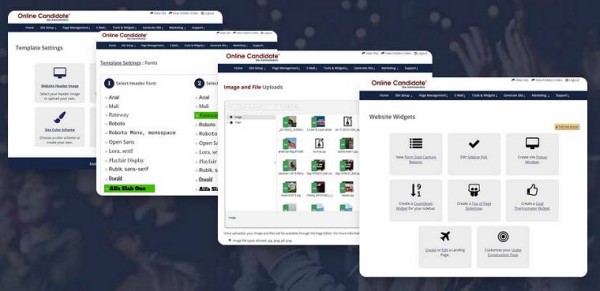
Online Candidate’s affordable, flexible website packages will get you online quickly and easily. Get your web design, hosting and ability to control your site is all in one package.
- Starting to fundraise? Get set up with our $29/month option and take donations online. As you campaign grows, you can upgrade to a custom design or have us set up your site content.
- Don’t have a campaign logo or header design? No logo, no problem. We’ll create one for your campaign. Our Enhanced Website Package includes a custom design, initial content setup and 12 months hosting.
- Add-on Options: To help your online campaign start quickly and easily, we offer a number of options to our campaign website packages. They include Site Launch, Social Media Setup and MailChimp design and integration and Candidate Intro Video. These options can be ordered at any time.
- What package is best for your campaign? Try our Package Option Tool to find out.
Political marketing services
Besides political websites, we offer digital campaign products and marketing services. This campaign seasons, look to Online Candidate for:
- Political IP Targeting: By matching a physical address to a specific IP with extreme precision, IP Targeting becomes a secret weapon for political campaigns. We make it easy to target the voters you want to directly reach. Learn more.
- Political Promo Video Design: Get a high-resolution campaign introduction video to kick off your YouTube channel, post to Facebook, and embed in your website. It’s a quick and affordable way to start another online promotional channel. Learn more.
- One-On-One Consulting: Looking for guidance on getting started on the web? Need help marketing your political campaign website? Our one-on-one web consulting services could help.
Helping candidates win elections since 2004
- Online Candidate provides an affordable political website builder to raise money and build support.
- Free resources on our client-only site OnlineCandidateResources.com.
- Addon services to help launch your website, create your social media accounts, build your email system.
Contact us today to get started on your next online campaign.
4 Challenges Candidates Face When Running A Political Campaign
Local political campaigns need to reach fewer voters and typically campaign for a shorter period than state or congressional campaigns. But navigating the complexities of political strategy and voter engagement is no less demanding at the local level.
Local candidates must deeply understand the demographics and the specific issues facing their constituents. You must employ effective electoral strategies under heavy constraints. In many ways, if you are running a small campaign, you have tough because:
- You are pressed for time.
- You are pressed for money.
- You need political campaign staff and volunteers.
- You need media and voter exposure.
- You need to engage in digital campaigning to maximize reach.
Depending on your local party committee, you may or may not get support from those organizations. This makes independent voter engagement efforts even more crucial. And if you are running as an independent candidate, you are pretty much on your own.
Here are the major challenges local candidates face when running a political campaign.
Want to listen to the story?
1. Putting together a political campaign team
 No candidate in a race of significant size can go it alone. One of the first challenges a candidate will face is finding a core group of volunteers. These people will become your primary campaign team who will organize events, coordinate fundraising, grow a volunteer base, handle sign distribution, and mailings.
No candidate in a race of significant size can go it alone. One of the first challenges a candidate will face is finding a core group of volunteers. These people will become your primary campaign team who will organize events, coordinate fundraising, grow a volunteer base, handle sign distribution, and mailings.
A political campaign committee is a legal entity that must be registered with your county or state. This can often be done electronically. You will also need to set up a checking account for the campaign for accept contributions and pay expenses.
The number of people on a campaign committee will vary. It may depend on your overall budget and the specific elected office you are running for.
A typical political campaign committee may consist of:
A campaign manager is open-ended position, and one of the most important positions on a campaign committee. They handle day-to-day duties, from overseeing fundraising, volunteer, and campaign staff, to attending events and advising the candidate in all types of matters.
In smaller political campaigns, the campaign manager’s duties may double as those of a press secretary.
Finding the right manager for your campaign can be tough. In small races, like alderman or town council, campaign managers often work as volunteers. In other races, they will be paid operatives.
The campaign manager reports directly to the candidate, and will act according to the candidate’s directives. He or she is responsible for putting the campaign plan into action. This includes not only spending and expenses, but also setting and achieving fundraising goals.
Campaign managers also:
- Work with other advisors and consultants
- Hires and manages the campaign’s operational team
- Makes tactical and strategic decisions throughout the race
- Delegates tasks when required
- Ensuring that laws and regulations are followed, and that all volunteers and staff are aware and follow them
Professional Tip: A political candidate should never act as their own campaign manager. Running a political campaign requires help, advice, and teamwork of others. One person cannot do it alone.
Campaign committee positions include:
- Campaign Treasurer: This person will handle the campaign’s finances and bookkeeping. The treasurer acts as the bookkeeper. They are often responsible for completing the required registration forms for election participation and establishing the campaign bank account.
- Volunteer Coordinator: As the name suggests, this person attracts, organizes, and heads up the volunteer efforts. This may include door-to-door canvassing, clerical work, and event staffing. They will be involved in a number of simultaneous functions. The person holding the volunteer coordinator position should be experienced in managing people.
- Sign Coordinator: This person solicits yard sign locations and is responsible for placing them. They will also help replace or repair them during the campaign.
Each member has their own duties while working together toward the larger goal. Additional roles may come in the form of:
- Scheduling Coordinator: This person is responsible for developing and executing campaign events. They might manage the candidate’s personal and campaign schedule and help prepare logistically for places that the candidate will attend.
- Campaign Fundraiser: This person’s sole focus is to help your campaign raise money. A good campaign fundraiser will also be on top of the candidate to make sure that he or she is doing what they need to do to raise money. (Dialing for dollars, mostly.)
- Activists: These are the people who will act as your volunteer foot soldiers. They may take part in activities such as door-to-door canvassing, making phone calls on behalf of the campaign, and social media promotion.
- Political consultants: The larger the campaign, the more likely you will find retained consultants on staff. Consultants are often used for communications efforts (television, mail, digital). They may also help with general strategy, operating phone banks, and more.
Your campaign committee will help steer your campaign. A diverse staff with a variety of skills and expertise will strengthen your organization.
2. Developing a message and theme that will resonate with voters
When campaigning for office, a candidate must create a theme that captures and defines what they stand for.
In creating a theme, assess the candidate’s or ballot measure’s strengths and weaknesses. Who will vote for you, and why? Shape your theme around the voters’ most important issues. Frame any negatives of your positions into positives. (The platform is not ‘anti-growth’, it’s ‘smart-growth’) Once you have created your message, it will become the foundation of your campaign – from your slogan and through all your advertising until Election Day.
Your “stump speech” will also define you as a candidate. It’s a summary of you, your plans to improve the community as an elected official, followed up with a request for support. This can be refined further to create an even shorter ‘elevator pitch’.
What is an elevator speech? An elevator speech, elevator pitch, or elevator presentation is a brief description that describes the candidate and what they stand for in a short amount of time. The entire length of an elevator speech is typically no more than thirty seconds.
[bctt tweet=”Your stump speech will define you as a candidate. Be sure to craft yours carefully.” username=”onlinecandidate”]
Whether you are running in local election, a state election, or even for a position on your local school board, simple messaging is key. You must engage in repetitive, engaging communication to make sure your message is understood by voters.
This requires pulling together all sides of your organization with the goal of expressing and reinforcing your message. Everyone needs to be on the same page, always.

3. Raising campaign funds and donations
Of all the challenges faced when running political campaigns, raising money is the biggest one. Elections are overwhelmingly won or lost based on the amount of money spent by a candidate. Even local elections can become expensive.
For example, in 2020, outside political groups spent more than $3.7 million attempting to sway the three competitive Los Angeles Unified School District board races. And this was just in the last two weeks of the election.
All it takes is one generous donor who supports an opponent, and the cost of your small-time election has just gone up. These days, you may also need to worry about outside money from PACs and various 529 organizations.
[bctt tweet=”All it takes is for one generous donor to help an opponent, and the cost of your small-time election has just gone up.” username=”onlinecandidate”]
Consider your potential costs in advertising, event costs, ancillary costs, and the expense of maintaining a campaign office. The numbers will quickly add up.
What to look for when figuring out your initial campaign budget:
- How much have others running for the same position raised in the past? Do your research on past races. Determine what the approximate cost per vote was. All things being equal, that will give you a rough benchmark for how much your election may cost.
- How much can your opponent raise? What has their fundraising history been for past races? Keep an eye on financial disclosures to see how much they are raising and spending.
- Determine how much you can personally contribute as ‘seed money’ from of your own pocket. Find out what other funds you can secure from your family and close friends.
- Your local or national party may provide financial assistance. Speak with them early on to determine what kind of support your campaign can expect.
Before you formally make a launch announcement, have your campaign website ready to collect donations. Raising funds early in the process builds momentum to attract others to support your political agenda.
Planning your budget is important. Voters usually don’t pay attention to local races until a few weeks before Election Day. You’ll want to have funds available for a final mailing or GOTV effort.

4. Getting enough media exposure
Some local races are non-partisan, so you may not be able to rely on party identification in the voting booth. Where possible, canvassing remains an effective way to reach voters. Going door-to-door can help increase turnout and is an effective GOTV method. Combined with your other advertising efforts, it can help ensure that your name is identifiable to voters on Election Day.
[bctt tweet=”When voting time comes, name recognition will make voters less likely to skip your line on the ballot.” username=”onlinecandidate”]
Name recognition will make voters less likely to skip your line on the ballot, which often happens when the voter does not know either candidate.
Half of organizing a political campaign is communication. Getting the word out can be tough, especially if your organization has a limited budget.
Here are a few tips for improving your campaign’s media exposure:
- Get to know your local election officials. They can help you navigate the political landscape and get you in touch with the right people in the media. Follow them on social media as well.
- Create an online press kit to make it easy for local reporters to learn more about you.
- Advertising in the local paper will increase awareness. There is always a wall between editorial and advertising in newspapers, but one way to get the attention of a newspaper and convince them you are a serious candidate is to place a few ads (offline and/or online).
- Secure your key endorsements early and promote them.
- Use simple and consistent messaging.
- Leverage online communication. Building a website and using social media to advertise are effective, inexpensive options for local campaigns.
The problems that come up during an election are almost endless, and we’ve only covered a few of them. Take the time to learn what you are getting into when you start your campaign. Even then, preparation and planning will only get you so far. Your team will have to deal with fundraising, spending, volunteers, advertising issues, your opposition, and voter outreach.
But good support, a good message, and a lot of hard work will, hopefully, give you an Election Day win!
Related: Should You Make The Run For Local Office?
Shane Daley is a partner and developer of OnlineCandidate.com. With over 15 years experience in web marketing and online political campaigning, Shane is the author of the book ‘Running for Office as an Online Candidate‘.
The Biggest Threat That Local Candidates Face
What’s the most dangerous threat facing every local candidate in the country next year?
It’s not fundraising, though that is always a challenge. It’s not social media platforms. It’ not misinformation. Nor will it be the number of yard signs you place or mailers you send.
No, the biggest threat to political candidates is an ‘off-year’ or ‘off-season’ election.
According to FairVote, voter turnout in the United States is about 60% in presidential elections and 40% in midterm election years.
Off-year turnout is even lower.
A study found that fewer than 15% of eligible voters cast a ballot for mayor in 10 of America’s 30 largest cities. Across the U.S., just 15 to 27 percent of eligible voters bother to vote in their local election.
Small town and villages often have even lower turnout in spring and local primary elections.
Why the poor turnout?
It’s likely a combination of issues, including the voting process, not knowing where or how to register to vote, a lack of media coverage on local candidates and issues, or it can be that many people don’t realize how local government affects their lives.
In the U.S., we have many layers of city and county government. Voters are asked to fill a variety of positions that have a direct impact on their daily lives. These local positions include:
- Executive offices like mayor and county executive make decisions that affect large groups of people.
- Legislative offices, such as the city council and county commissioners, make local laws and ordinances.
- Positions within the justice system, including judges, district attorneys, and sheriffs, greatly influence the dispensation of the law.
- County and city positions have a direct impact on everything from government services to how local elections are run.
- School board members that influence local education budgets, curriculum and policies.
- Voters also determine the outcome of community issues through local ballot measures and referendums.
Your goal this cycle should be to let people know exactly why their vote matters, and why voting for you will make a difference to them.
Every year is an election year.
Your campaign will need to work harder to remind voters of that fact.
Apathy and low voter turnout are the greatest threats to your candidacy.
Getting voters to show up will make the difference between winning and losing.
If you are not working to solve that problem now, then you are getting off on the wrong foot.
Are You Ready to Run for Office? Take the test and find out!


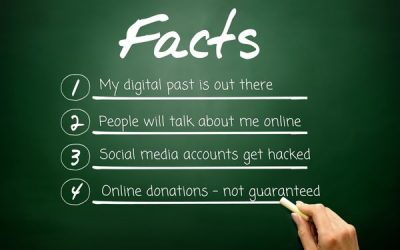
 There’s no guarantee that the web will pull in money
There’s no guarantee that the web will pull in money
